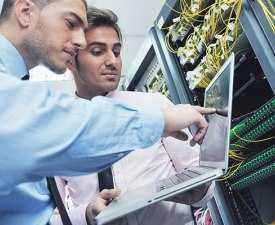Description
Course Name: Post Graduate Diploma in Computer Hardware and Networking
Course Id: PGDCH&N/Q1001.
Education Qualification: Graduate.
Duration: 370 Hrs.
How You will Get Diploma Certificate:
Step 1- Select your Course for Certification.
Step 2- Click on Enroll Now.
Step 3- Proceed to Enroll Now.
Step 4- Fill Your Billing Details and Proceed to Pay.
Step 5- You Will be Redirected to Payment Gateway, Pay Course and Exam Fee by Following Options.
Card(Debit/Credit), Wallet, Paytm, Net banking, UPI and Google pay.
Step 6- After Payment You will receive Study Material on your email id.
Step 7- After Completion of Course Study give Online Examination.
Step 8- After Online Examination you will get Diploma Certificate soft copy(Scan Copy) and Hard Copy(Original With Seal and Sign).
Step 9- After Certification you will receive Prospect Job Opportunities as per your Interest Area.
Online Examination Detail:
- Duration- 120 minutes.
- No. of Questions- 60. (Multiple Choice Questions).
- 10 Questions from each module, each carry 10 marks.
- Maximum Marks- 600, Passing Marks- 40%.
- There is no negative marking in this module.
| How Students will be Graded: | ||
| S.No. | Marks | Grade |
| 1 | 91-100 | O (Outstanding) |
| 2 | 81-90 | A (Excellent) |
| 3 | 71-80 | A (Very Good) |
| 4 | 61-70 | B (Good) |
| 5 | 51-60 | C (Average) |
| 6 | 41-50 | P (Pass) |
| 7 | 0-40 | F (Fail) |
Benefits of Certification:
- Government Authorized Assessment Agency Certification.
- Certificate Valid for Lifetime.
- Lifetime Verification of Certificate.
- Free Job Assistance as per your Interest Area.
Syllabus
Post Graduate Diploma in Computer Hardware and Networking
Fundamentals of Information Technology and MS-Office
Characteristics of computer, Evolution of Computer, Block Diagram Of a computer, Generations of Computer, Classification Of Computers, Applications of Computer, Capabilities and limitations of computer, Basic Computer Organization: Role of I/O devices in a computer system. Input Units: Keyboard, Terminals and its types. Pointing Devices, Scanners and its types, Voice Recognition Systems, Vision Input System, Touch Screen, Output Units: Monitors and its types. Printers: Impact Printers and its types. Non Impact Printers and its types, Plotters, types of plotters, Sound cards, Speakers, Storage Fundamentals, Software, Operating System, Data Communication, Business Data Processing, Computer Arithmetic.
Computer Hardware and Maintenance
Perform all the functions with Electrical and Electronic Components related to Computer and Networking system drawing following safety precautions, Assemble and repair Desktop Computer with all its hardware components, Install different Operating System and all other application software, Customize Operating System and maintenance of system application software, Assemble and repair Laptop and its hardware components, Perform the operations of office package (word, excel, power point), Install Printer, Scanner and troubleshoot their faults, Set up and configure Networking System using various network devices, Share and control resource and Internet connection through network. 10. Implement Network Security to protect from various attacks on networking, Install and configure Windows and Linux server, Browse internet and communicate through email.
Operating System & Diagnostics Tools
Brief Introduction to System Software, Compiler, Assembler, Loader, Operating system, Brief history of DOS, and WINDOWS, Main features of DOS, Directory structure of DOS, File structure of DOS, Detail concept of DOS commands, Introduction to Windows, Types of Operating Systems, Importance of Operating Systems, Softness organization, Linking, loading and executing control program, Functions of Operating System, Memory Management Function (Principles and Brief Concept), I/O Management Functions (Principles and Brief Concept), File Management Principles and Brief Concept Types of File System,Simple file system, Basic file system, Logical file system, Physical file system.
Windows 2007 Server Administration
Introduces the student to Microsoft Windows Server. Students will learn the basics of installing, Installation of Windows Server, Windows Server file systems, NTFS Security, Installation and administration of Active Directory services, Create and administer user and group accounts, user and group policies, Network protocols and services supported by Windows Server, Enable and configure Routing and Remote Access Service, Backup and restoration of data. Implementation of a disaster recovery plan, Monitoring and optimizing performance of a Windows Server implementation.
Network Essentials & Management
The concept of network communication, the basic requirements for getting online, Create a simulated network using Packet Tracer, Build a simple home network, the importance of standards and protocols in network communications, protocols enable network operations, communication occurs on Ethernet networks, Create a fully connected Local Area Network (LAN), the features of an Internet Protocol (IP) address, the Dynamic Host Configuration Protocol (DHCP) address assignment process, the principles of Internet Protocol version 4 (ipv4) and ipv6 address management, clients access internet services, the function of common application layer services, Configure an integrated wireless router and wireless client to securely connect to the internet, Implement virtualization and cloud technologies, to use security best practices to mitigate attacks, Configure basic network security, Compare in-band and out-of-band management access. Use the Cisco IOS, Build a simple computer network using Cisco devices.
Principal of Digital Electronics
Number Systems, Analogue Versus Digital, Introduction to Number Systems, Decimal Number System, Binary Number System, Advantages, Octal Number System, Binary Codes, Binary Coded Decimal, BCD-to-Binary Conversion, Binary-to-BCD Conversion, Higher-density BCD Encoding, Digital Arithmetic, Basic Rules of Binary Addition and Subtraction, Addition of Larger-bit Binary Numbers, Addition Using the 2’s Complement Method, Subtraction of Larger-bit Binary Numbers, Logic Gates and Related Devices, Logic Families, Boolean Algebra and Simplification Techniques, Arithmetic Circuits, Multiplexers and Demultiplexers, Programmable Logic Devices, Flip-flops and Related Devices, Counters and Registers, Data Conversion Circuits – D/A and A/D Converters, Microprocessors, Microcontrollers.

